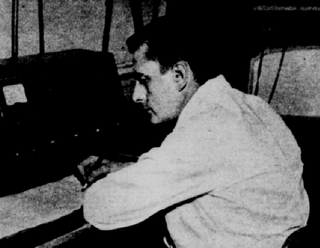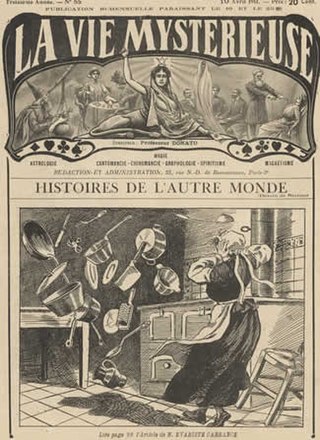
Clairvoyance is the claimed ability to acquire information that would be considered impossible to get through scientifically proven sensations, thus classified as extrasensory perception, or "sixth sense". Any person who is claimed to have such ability is said to be a clairvoyant.

Parapsychology is the study of alleged psychic phenomena and other paranormal claims, for example, those related to near-death experiences, synchronicity, apparitional experiences, etc. Criticized as being a pseudoscience, the majority of mainstream scientists reject it. Parapsychology has also been criticized by mainstream critics for claims by many of its practitioners that their studies are plausible despite a lack of convincing evidence after more than a century of research for the existence of any psychic phenomena.
Parapsychology is a field of research that studies a number of ostensible paranormal phenomena, including telepathy, precognition, clairvoyance, psychokinesis, near-death experiences, reincarnation, and apparitional experiences.

Telepathy is the purported vicarious transmission of information from one person's mind to another's without using any known human sensory channels or physical interaction. The term was first coined in 1882 by the classical scholar Frederic W. H. Myers, a founder of the Society for Psychical Research (SPR), and has remained more popular than the earlier expression thought-transference.

A psychic is a person who claims to use powers rooted in parapsychology such as extrasensory perception (ESP) to identify information hidden from the normal senses, particularly involving telepathy or clairvoyance, or who performs acts that are apparently inexplicable by natural laws, such as psychokinesis or teleportation. Although many people believe in psychic abilities, the scientific consensus is that there is no proof of the existence of such powers, and describes the practice as pseudoscience. The word "psychic" is also used as an adjective to describe such abilities.

A ganzfeld experiment is an assessment used by parapsychologists that they contend can test for extrasensory perception (ESP) or telepathy. In these experiments, a "sender" attempts to mentally transmit an image to a "receiver" who is in a state of sensory deprivation. The receiver is normally asked to choose between a limited number of options for what the transmission was supposed to be and parapsychologists who propose that such telepathy is possible argue that rates of success above the expectation from randomness are evidence for ESP. Consistent, independent replication of ganzfeld experiments has not been achieved, and, in spite of strenuous arguments by parapsychologists to the contrary, there is no validated evidence accepted by the wider scientific community for the existence of any parapsychological phenomena. Ongoing parapsychology research using ganzfeld experiments has been criticized by independent reviewers as having the hallmarks of pseudoscience.

An out-of-body experience is a phenomenon in which a person perceives the world from a location outside their physical body. An OBE is a form of autoscopy, although this term is more commonly used to refer to the pathological condition of seeing a second self, or doppelgänger.
Paranormal events are purported phenomena described in popular culture, folk, and other non-scientific bodies of knowledge, whose existence within these contexts is described as being beyond the scope of normal scientific understanding. Notable paranormal beliefs include those that pertain to extrasensory perception, spiritualism and the pseudosciences of ghost hunting, cryptozoology, and ufology.
Charles Henry Honorton was an American parapsychologist and was one of the leaders of a collegial group of researchers who were determined to apply established scientific research methods to the examination of what they called "anomalous information transfer" and other phenomena associated with the "mind/body problem"—the idea that mind might, at least in some respects, have a physical existence independent of the body.

Christopher (Chris) Charles French is a British psychologist who is prominent in the field of anomalistic psychology, with a focus on the psychology of paranormal beliefs and anomalous experiences. In addition to his academic activities, French frequently appears on radio and television to provide a skeptical perspective on paranormal claims.

Stanley Krippner is an American psychologist and parapsychologist. He received a B.S. degree from the University of Wisconsin–Madison in 1954 and M.A. (1957) and Ph.D. (1961) degrees from Northwestern University.

Richard J. Wiseman is a professor of the public understanding of psychology at the University of Hertfordshire in the United Kingdom. He has written several psychology books. He has given keynote addresses to The Royal Society, The Swiss Economic Forum, Google and Amazon. He is a fellow for the Committee for Skeptical Inquiry and a patron of Humanists UK. Wiseman is also the creator of the YouTube channels Quirkology and In59Seconds.
Robert Lyle Morris was an American psychologist, parapsychologist and professor at the University of Edinburgh, where he was the first holder of the Koestler Chair of Parapsychology at the Koestler Parapsychology Unit.
Erlendur Haraldsson was a professor emeritus of psychology on the faculty of social science at the University of Iceland. He published in various psychology and psychiatry journals. In addition, he published parapsychology books and authored a number of papers for parapsychology journals.
Michael Anthony Thalbourne was an Australian psychologist who worked in the field of parapsychology. He was educated at the University of Adelaide and the University of Edinburgh. His books include: A glossary of terms used in parapsychology (2003), The common thread between ESP and PK (2004), and Parapsychology in the Twenty-First Century: Essays on the future of Psychical Research (2005).
In psychology, anomalistic psychology is the study of human behaviour and experience connected with what is often called the paranormal, with few assumptions made about the validity of the reported phenomena.

Telekinesis is a hypothetical psychic ability allowing an individual to influence a physical system without physical interaction. Experiments to prove the existence of telekinesis have historically been criticized for lack of proper controls and repeatability. There is no reliable evidence that telekinesis is a real phenomenon, and the topic is generally regarded as pseudoscience.
The Perrott–Warrick Fund is administered by Trinity College, Cambridge, and awards grants for research in parapsychology. According to Susan Blackmore, it is the second largest source of grants for psychical research in the UK, after the University of Edinburgh's Koestler Parapsychology Unit. Caroline Watt of the University of Edinburgh has been Perrott–Warrick Senior Researcher since 2010. The position was previously held by Rupert Sheldrake, Richard Wiseman and Nicholas Humphrey.
The Koestler Parapsychology Unit is a research group established in 1985 at the University of Edinburgh, in Scotland, to teach and conduct research concerning various aspects of parapsychology. It hosts the only endowed chair of parapsychology in the UK, established by a bequest following the suicide in 1983 of internationally acclaimed intellectual, writer and journalist Arthur Koestler. The first person to hold the chair, beginning in 1985, was Robert L. Morris. John Beloff and Joshua Snyder were instrumental in setting it up. The chair is currently held by Professor Caroline Watt.

John Beloff was an English psychology professor at Edinburgh University and parapsychologist.










